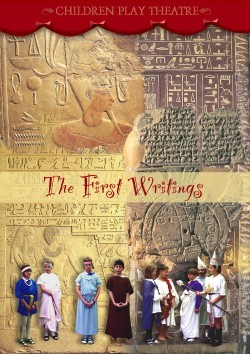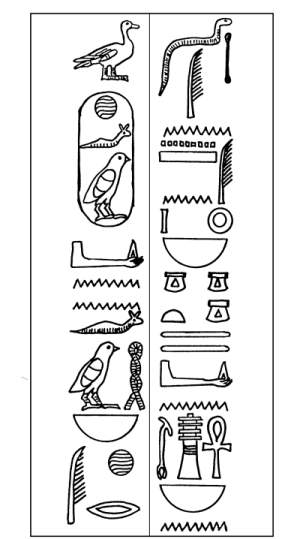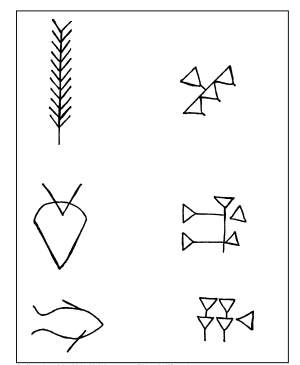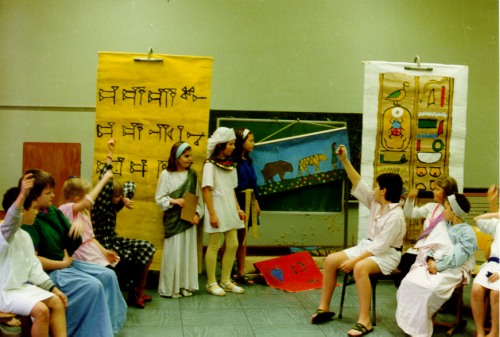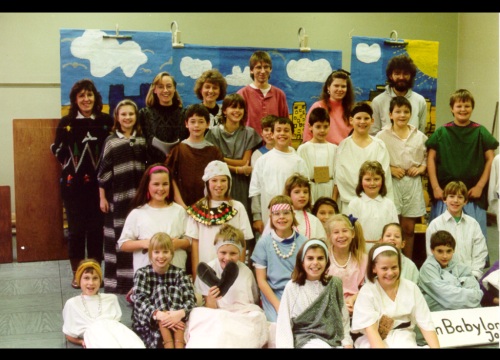|
~ The First Writings ~ Summary
Excerpts: The First Writings Prologue
Two children step in front of the audience. They are dressed in “Babylonian” clothes: white, red, or blue tunic kind shirt-dresses. They wear hairbands and a lot of jewellery: necklaces, earrings and fingerings. Child 1: Dear audience. With our play today, we'd like to show and tell you something about the very first scripts. Child 2: Those scripts were the cuneiform script and hieroglyphics. Child 1: They were invented almost simultaneously, about 5000 years ago. The cuneiform script was invented in the Land of the Two Rivers. This is where you will find today's "Iraq". Hieroglyphics were invented in Egypt. Child 2: Before people had invented scripts, they were drawing pictures when they wanted to tell something. Child 1: These drawings however, were not quite yet, what can be considered “writing”. Because symbols and drawings can only be considered a script if everyone who reads them will not only read the same meaning but also the same verbatim. Child 2: But precisely this was possible when using the cuneiform script or hieroglyphics. Therefore these two are the first scripts. Child 1: Dear audience we will now take you to an era about 3000 years ago, to the Land of the Two Rivers and to the city of Babylon. This is where the Tower of Babel used to be. Child 2: Although the cuneiform script was already almost 2000 years old by that time, it had not basically changed since its invention. End of the Prologue .... Rahotep: Hello students. Teacher: Rahotep is very interested in our script. This is why we should tell him something about it. He might then tell us something about his script. Rahotep: Yes, that would be very interesting for me. Teacher: (Points to one student) Dummuk, how did it start with our script? Dummuk: It was about 2000 years ago. (Attaches the picture of the first glyphs and the cuneiform script symbols) If a farmer or tradesman delivered a sack of crops to the temple, a symbol was carved into a clay board. A symbol for an ox looked like this (pointing to it), and this here was the symbol for fishes. Teacher: Thank you, Dummuk. Labashi (points to the student), how did it continue after this? Labashi: As time went by, writers found it awkward to always draw such complicated pictures (points to the drawings). This is why they moved on to draw simple lines instead of pictures (pointing to one cuneiform script symbol). It was quicker. Teacher: Good. Sit down. Within a very short period of time, other symbols for lots of other words were invented. (Sargon puts his hand up) Yes, Sargon, what would you like to say? Sargon: But if one was to invent specific symbols for each word of a language, one would need many thousands of symbols and no-one could ever remember them. Teacher: True. And how did the inventors of scripts solve this problem? Semiramis. Semiramis: They had an idea. You see: each picture or symbol which stands for a whole word can also stand for just one syllable of another word. Every symbol can therefore be used as a whole word or as a syllable only. Egibi: In this way, one needs far fewer symbols than one would if one invented specific symbols for each word. Because every word is composed of syllables and there are far fewer syllables in a language than there are words. Teacher: Correct. So there are word symbols and syllable symbols in our script. But what happens if for instance someone wrote down the symbol for "wood" . How could the reader tell if it means wood as in forest, or if it stands for wood as in timber? Sargon: You put another symbol in front of the word wood which clearly shows whether it means forest or timber.
Proposals for sceneries:
Prayer for a Pharao (scene 2, right side) ....
Cuneiform script symbols and their
original pictures: corn, ox, fish
(scene 2, central part) ....
Winged
lions on a wall (scene 3, left side)
Photos of a production:
|
||||||
|
webmaster: designcase.net Copyright © 2007 kinderspielentheater.de |
||||||

